This all-in-one TikTok advertising guide is for brands to get started and see results, plus some best-in-class brand examples.
TikTok continues to be the go-to platform for brands seeking bold, creative (and increasingly high-performing) social and video advertising strategies. By Q3 2025, TikTok’s advertising ecosystem has evolved dramatically, with smarter targeting, fresh formats, and more seamless integration with eCommerce and creator-led marketing.
If your brand hasn’t revisited TikTok Ads since 2022, now’s the time.
This guide brings that refreshed lens, melding proven evergreen strategies with today’s innovations and cost benchmarks. Whether you’re aiming to build brand awareness, drive conversions, or spark views, this guide has everything from setting up Ads Manager to capturing viral momentum.
How Much Does It Cost to Advertise on TikTok?
Advertising on TikTok in Q3 2025 remains highly accessible, but pricing can vary widely based on format, targeting, and campaign goals.
Typical TikTok Ad Cost Ranges (2025 Benchmarks)
Costs can vary widely depending on whether you’re promoting an app, a physical product, or a service, as well as on campaign goals and targeting.
1. CPM (Cost Per Thousand Impressions)
- Generally ranges from $10 to $20 for broad brand awareness campaigns.
- For app install campaigns, CPMs may be on the higher side due to competitive app categories and mobile-focused audiences.
- For product campaigns targeting niche audiences, CPMs might be slightly lower but vary depending on targeting precision and ad creative quality.
2. CPC (Cost Per Click)
- Typically between $0.10 to $0.50.
- For apps, CPCs tend to be on the higher end since clicks often lead directly to app installs or registrations, which have clear value.
- For physical products or e-commerce, CPC can vary based on the product category, but well-optimized campaigns can often stay near the lower end.
3. CPI (Cost Per Install)
- CPI (Cost Per Install) for app campaigns can range from $1.00 to $4.00+ depending on the app category, region, and competition.
- For well-optimized app campaigns in less competitive niches or regions, CPI might be as low as $0.50.
4. CPA (Cost Per Acquisition)
- CPA (Cost Per Acquisition) for product sales or leads typically ranges from $10 to $50, again depending on price point, niche, and funnel complexity.
- Campaigns focused on higher-value products or subscriptions may see higher CPA but justify it with higher customer lifetime value (LTV).
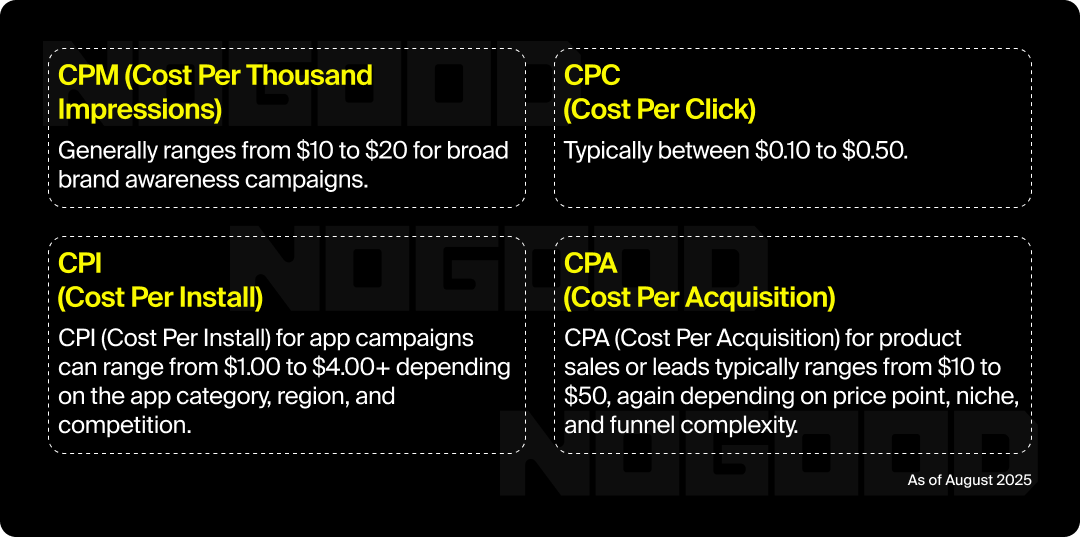
Factors influencing costs include:
- Ad Format: In-Feed, Spark, Branded Effects, and Live Shopping are the available types of ad formats on TikTok.
- Targeting Level: Broad demographic targeting tends to be cheaper, while hyper-targeting (e.g., regional plus interests) can drive up costs and CPMs.
- Placement Choices: Opting into placements like TikTok Shop can add value; and cost.
- Auction Dynamics: Peak periods like late Q3 promotions (think back-to-school, pre-Q4) can see bidding competition and CPM inflation.
Tips to Optimize TikTok Ad Spend
- Test one variable at a time (e.g., creative only, or targeting only) to isolate what drives results.
- Take advantage of TikTok’s seasonal trends tool to align ads with momentum while managing cost per view.
- Start with a moderate budget and scale high-performing ads via “performance plus” auto-bidding.
Is TikTok Good for Advertising?
Absolutely! TikTok remains one of the most potent platforms for engagement and growth. Here’s why TikTok advertising is a great marketing tool:
- Audience Reach & Engagement: With over 2 billion users globally and an engagement rate that outperforms Instagram and YouTube in short-form formats, TikTok is uniquely positioned to boost both brand visibility and participation.
- Content-First Environment: TikTok’s culture rewards authenticity. Brands that lean into native storytelling (especially using creators and UGC) outperform polished, ad-style content in both CTR and share rate.
- Platform Advancements: TikTok has continued to expand its brand solutions, adding AI optimization, enhanced analytics dashboards, AR filters, and smoother Shop integrations.
- Versatile Objectives: Whether it’s driving app installs, building awareness, or prompting lead actions, TikTok offers objective-based campaigns that align with each brand funnel stage.
Q3 2025 Enhancement Highlights:
- TikTok Creative Center now offers performance benchmark insights by vertical and format, helping advertisers make data-guided creative tweaks.
- Shop Ads and Live Shopping broaden commerce paths; especially valuable for DTC and fashion brands.
- TikTok’s ad placements now include improved CTA overlay options and shoppable AR filters, bringing content and purchase actions closer than ever.
In short, for any brand willing to lean into creative trends and paired with smart targeting, TikTok delivers.
How Do I Get 1,000 Views on TikTok Fast?
Getting 1,000 views may sound trivial; but in the TikTok ecosystem, how you get there matters. Here’s how to do it fast and smart in Q3 2025.
- Leverage Trending Sounds & Hashtags: Jump into trending tracks or audio, pairing them with your brand’s message. TikTok’s algorithm favors videos that engage early, so being on trend helps.
- Use Spark Ads: Instead of traditional In-Feed ads, Spark lets you promote your own (or user-generated) organic content as an ad. This increases authenticity and early engagement.
- Use UGC or Creator Content: Collaborate with micro-influencers (10k-100k followers) for cost-effective, targeted reach. Creators bring trust; combining that with targeted ads amplifies impact.
- Add a Strong Hook in the First Three Seconds: Quick questions, surprising visuals, or tension-based opening lines work best. TikTok users decide fast.
- Use TikTok’s CTA Buttons, Effects & Stickers: If you want that visibility, make your content interactive. Polls, stickers, or animated elements grab attention.
- Post at Optimal Times: Monitor your specific audience analytics. Typically, posting during late-afternoon or early-evening in your local time zone sees higher initial velocity.
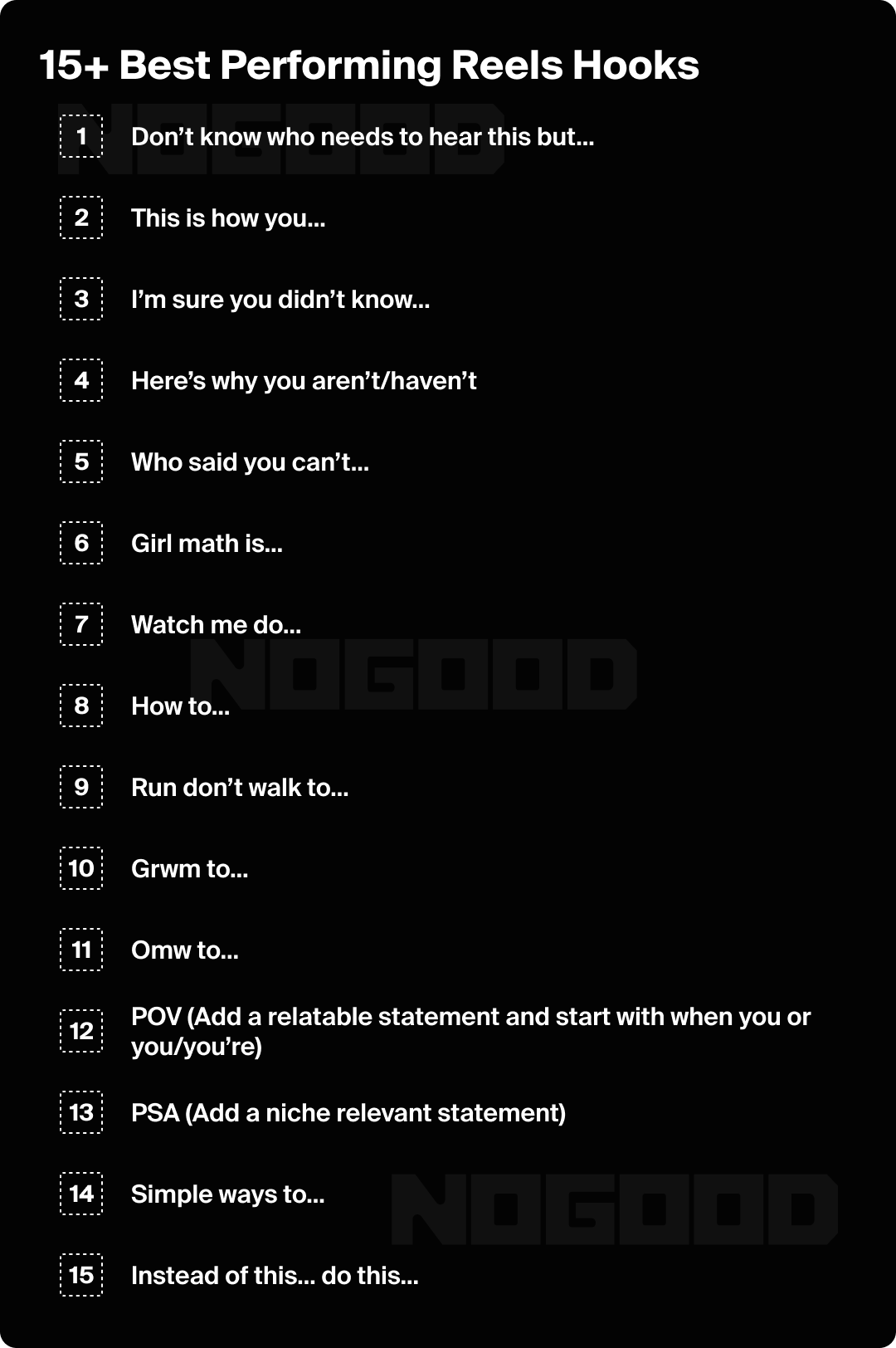
Combining these tactics typically gets you not just 1,000 views, but overall higher engagement and audience retention. It is also important to be consistent with posting; the more you post, the more the chance of viral traffic.
How Do You Do Advertising on TikTok?
Setting up TikTok Ads effectively remains a straightforward (but strategic) path.
Step 1: Create a Business Center Account
Sign up at TikTok Business Center and register your brand or client account. Set up your admin team, link pixels, and connect any Shop integrations.
Step 2: Access TikTok Ads Manager
Familiarize yourself with the TikTok Ads Manager and the structure of TikTok ad campaigns. This structure includes:
- Campaign: Objective (e.g., Awareness, Traffic, App Install, or Conversions).
- Ad Group: Budget, schedule, targeting, and placement.
- Creative: Format, assets, CTAs, and landing page(s).
Step 3: Set Your Objective & Bidding Strategy
Choose from Awareness, Traffic, App Installs, or Conversions. TikTok’s auto-bid tools (e.g., “Lowest Cost with Cap” or “Contract Bidding”) can help manage the pacing of your ad campaigns so that you don’t over or under-spend.
Step 4: Select Ad Formats
TikTok has several ad formats, all of which appear in slightly different places and could be used to achieve different campaign goals:
In-Feed TikTok Ads
In-Feed Ads are native video ads that appear directly in users’ “For You” feeds, seamlessly blending with organic content. These ads can be up to 60 seconds long and are skippable, giving users control over what they watch.
Because brands create original content specifically for these ads, In-Feed Ads offer full creative control and are ideal for direct response objectives such as driving app installs, website visits, or product sales. Their native placement helps them feel less intrusive and more engaging compared to traditional ads.
TikTok Spark Ads
Spark Ads allow brands to amplify existing organic TikTok videos, either from their own account or by way of the creators that they partner with (with permission, of course). Unlike In-Feed Ads, Spark Ads boost real, authentic content that already has engagement like likes, comments, and shares.
This format is especially effective for leveraging influencer content or viral user-generated videos to build trust and credibility, making the ad feel more native and less commercial. Spark Ads are a great choice when you want to capitalize on existing momentum without producing new videos.
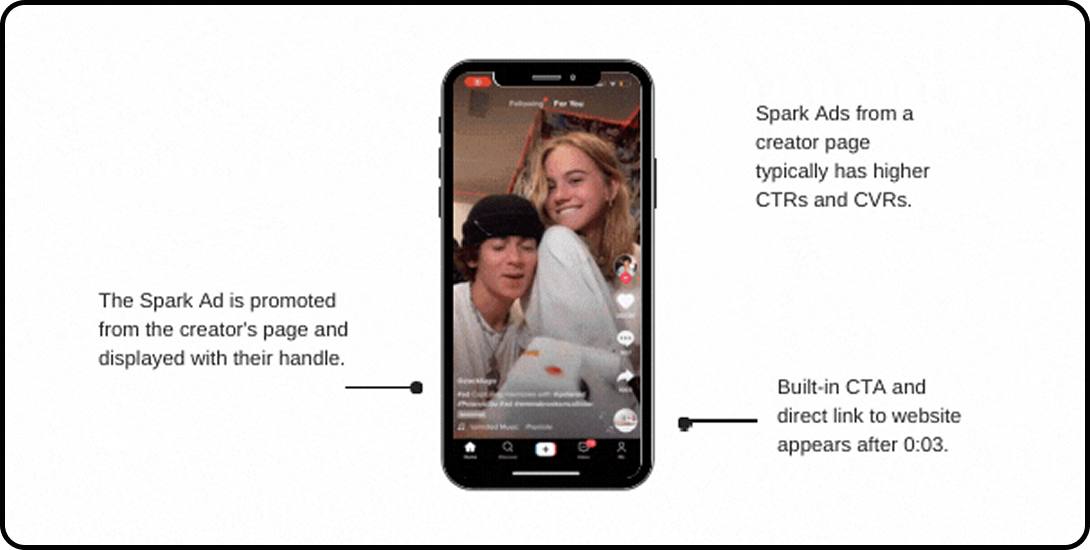
TikTok Branded Takeovers
Branded Takeovers are high-impact, full-screen ads that appear immediately when a user opens TikTok, capturing their attention instantly. These can be videos, GIFs, or static images and usually include links to landing pages or hashtag challenges. This format is excellent for rapid brand awareness or product launches due to its unavoidable placement.
TikTok Effect Ads
Effect Ads involve custom branded AR filters, stickers, or special effects that users can apply to their videos, encouraging creativity and user interaction. Effect ads focus on brand engagement and creating viral buzz by fostering the ongoing creation of user-generated content.
TikTok Live Shopping, Shop Ads & AR Lenses
These are TikTok’s eCommerce-focused formats, designed to drive purchases directly through the app.
- Live Shopping enables creators or brands to showcase products in real-time video streams with clickable links for instant buying.
- Shop Ads are product-focused ads integrated with TikTok’s shopping features to promote sales efficiently.
- AR Lenses are augmented reality filters that users can interact with, often featuring branded products or themes to enhance immersive engagement.
These formats are tailored to boost eCommerce, combining entertainment with seamless shopping experiences.
Step 5: Define Targeting & Creative
Once you have selected the ideal ad format for your campaign goals, it’s time to build your audience. Targeting includes demographics, interests, behavior, and custom audiences (e.g., pixel-based visitors).
Creative for TikTok ads should always be in the form of vertical video (1080×1920) with a strong hook, clean overlay text, and a persistent CTA.
Step 6: Optimize & Monitor
Once you’ve launched your TikTok ad campaign, it’s not quite the end of the story; like with most paid advertising, these campaigns require constant optimization and monitoring. Use TikTok’s built-in analytics to:
- Track impressions, reach, CTR, video play rate, and conversion rate.
- Conduct A/B tests on creative, copy, audience, and format.
- Adjust your creative mix by using insights from TikTok Creative Center.
Step 7: Scale What Works
- Scale budgets gradually, duplicating high-performing ad groups.
- Experiment with dynamic spark assets and content rotation.
- Retarget engaged users with sequential messaging or new angles.
New TikTok Advertising Features (August 2025)
Since our original guide, TikTok has rolled out enhancements geared toward better performance, creativity, and eCommerce.
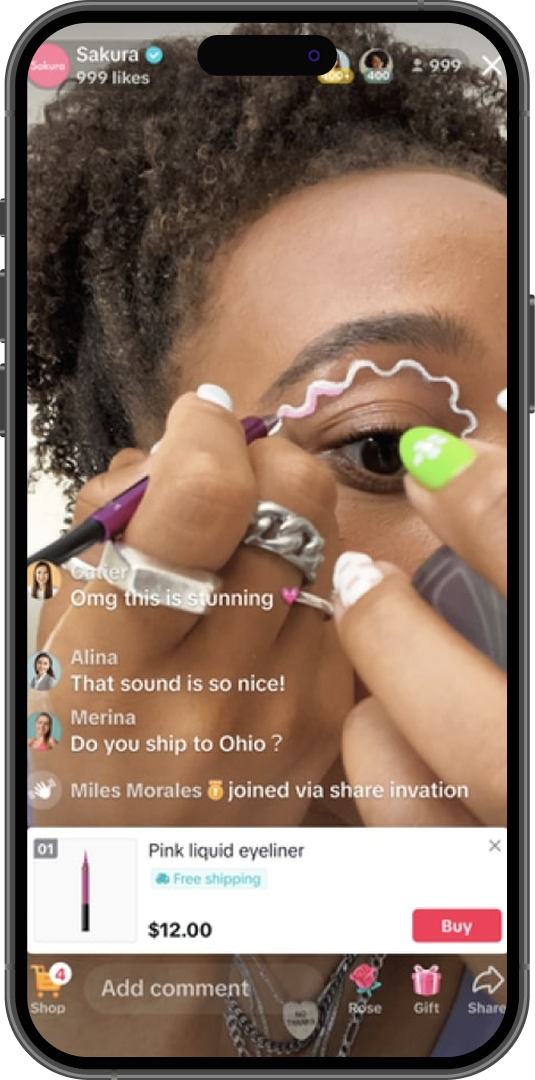
- Live Shopping & Shop Ads Expansion
TikTok’s live shopping continues to mature in Q3 2025, offering real-time engagement and shoppable stream overlays. Shop Ads integration allows seamless in-video catalog browsing. - AI & Creative Optimization
Enhanced A/B testing and AI suggestions now help with copy, visuals, and trending template recommendations. The TikTok Creative Centre’s benchmarking data (including format-based performance) helps craft top-performing creative. - AR & Interactive Effects
Branded AR filters with shoppable overlays have become mainstream tools for engagement-first brands; especially in beauty, accessories, and gaming. - Cross-Channel Repurposing & UGC Amplification
Best-practice is now reusing TikTok ads as Reels, Shorts, or Pinterest videos, supercharging ROI on creative investment. Spark Ads facilitate UGC amplification. - Enhanced Analytics Dashboards
Advanced dashboards allow filterable metrics for audience segments, creative types, and engagement rates within and across campaigns.
Brand Examples
Here are some refreshed case studies, inspired by brands from the original guide (now with Q3 2025 context).
- Duolingo: Leveraged Spark Ads to amplify user-generated reaction videos, achieving 2x the typical video completion rate and 30% higher CTR by tapping into humor and narrative storytelling.
- Pepsi: Ran a back-to-school In-Feed with AR selfie filters showcasing Pepsi flavors; integrated with Shop Ads, generating a 15% increase in catalog sales.
- e.l.f. Cosmetics: Led a Branded Hashtag Challenge tied to song lyrics trending in August of 2025, garnering 40 million views and a 25% rise in site traffic.
- L’Oréal: Paired AR Lipstick Try-On effect with Spark Ads featuring real customer UGC. Achieved a 3x increase in engagement versus traditional ads.
- ASOS: Targeted Gen-Z bundle deals via Live Shopping streams (partnered with micro-creators to showcase outfits) resulting in 2x conversion rate across events.
- Mercedes-Benz: Used In-Feed video ad series to tell mini-stories of customer journeys with their EV models; paired with lead-generation forms, resulted in lower CPL and higher test-drive sign-ups.
- Bumble: Deployed “day-in-the-life” creator content using Spark Ads, achieving 50% higher swipe-through than plain static ads.
Each demonstrates a creative tactic tied to a business result; great templates to reference for other brands.
The Path to Virality in 2025
Going viral on TikTok in 2025 is less about chance and more about strategic creativity:
- Prioritize Authenticity Over Gloss: Polished videos still win, but only if they feel native. The algorithm favors content that resonates as “real.”
- Partner with Creators, Not Influencers: Micro-creators bring niche authenticity and cost efficiency.
- Jump on Micro Trends Fast: Use TikTok’s Trends and Discovery tabs for inspiration, and be ready to iterate content within hours.
- Recycle Across Formats: Test the same ad across vertical formats on TikTok, Instagram Reels, YouTube Shorts, and Pinterest.
- Layer Your Strategy: Use spark ads for reach, in-feed for storytelling, Shop Ads for commerce, and retarget through sequential messaging.
- Leverage Analytics Continuously: Tweak underperforming metrics (e.g., drop-off points, CTR) within each ad group regularly.
Conclusion
TikTok’s advertising landscape in Q3 2025 continues to offer exciting opportunities and impactful outcomes for brands; especially for those willing to think creatively and adapt to evolving formats like Live Shopping, AR filters, and eCommerce-ready Spark Ads.
By using the benchmarked costs, updated best practices, and case examples in this guide, your team has what it takes to make TikTok a central pillar in your growth strategy.
Need hands-on help building your TikTok Ads playbook or scaling campaigns for Q3 2025? Check out our TikTok Studio capabilities, Growth Marketing solutions, or consult our team to create clear, measurable impact.
Thanks to the original NoGood November 2022 guide for laying the foundation; this refreshed edition is designed to keep you ahead.





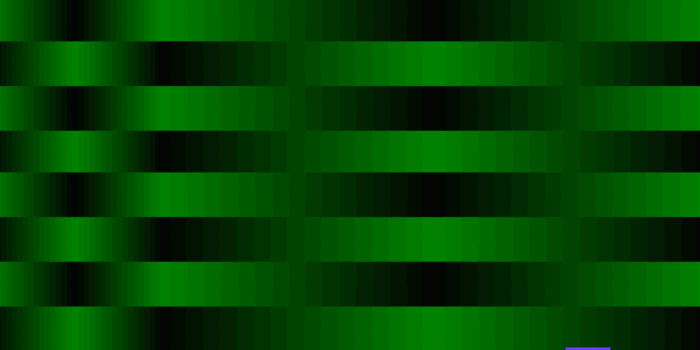

topic reach with information and analysis, very useful and informative